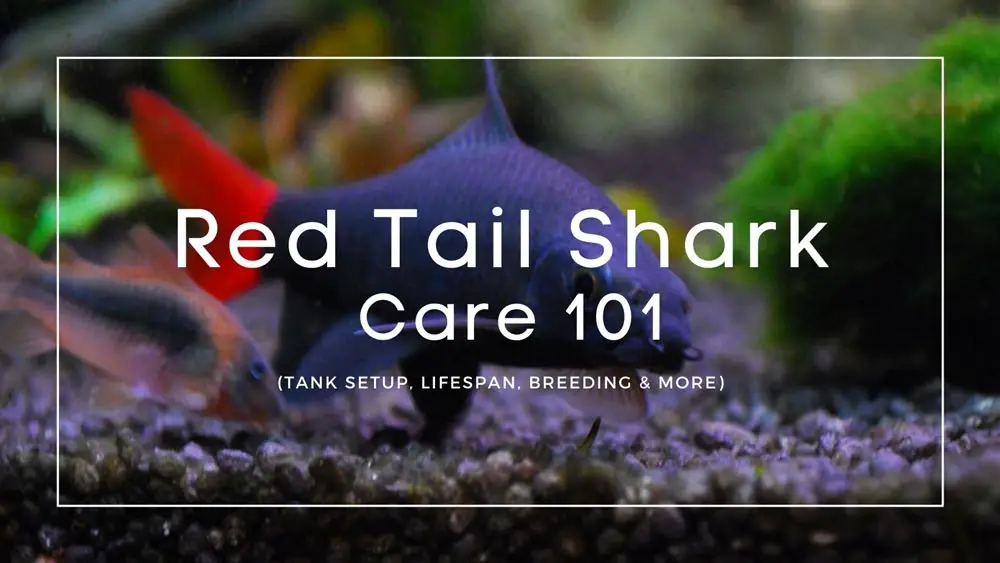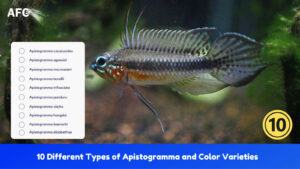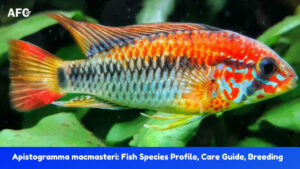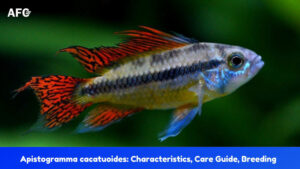Red tail sharks are among the most striking freshwater aquarium fish you can find. They’re bright and beautiful, active swimmers, and stand out in almost any tank. Like any fish, they do have some care requirements and behaviors you should know before introducing them to your home tank.
In this article, we’ll cover everything you need to know about the Red Tail Shark, including their origins, behavior, tank and feeding needs, and a lot more.
The Red Tail Shark (Epalzeorhynchos Bicolor) also goes by Red-tailed black shark, is a fish native to Thailand. Once common in Thailand’s streams and small fresh-water bodies, it’s now thought to be extinct in Thailand. Unfortunately poaching for the fish tank trade is thought to be behind the species’ disappearance from its native habitats. But the same fish tank trade now keeps the species alive.
While it’s called a shark and looks and acts much like a shark, you don’t have to worry about this fish trying to chow down on its tank mates. The Red Tail Shark is a member of the carp family, needs a high-quality diet, and prefers its own space.
Red Tail Shark Behavior
Red Tail Sharks are considered a semi-aggressive fish. They don’t generally get into fights or cause problems in your tank just because they can. But they are a territorial fish, and well capable of harassing other fish to death if they don’t have enough space and high-quality food.
A happy Red Tail Shark will spend a lot of its time cruising through the water looking for food. It isn’t a schooling fish and won’t usually join a school or tank mates (although they can encourage schooling behavior in other fish).
They also occasionally zip back and forth across the bottom of the tank, just above the substrate. This is normal behavior in a Red Tail Shark not a cause for concern.
Red Tail Sharks often tend to find a secluded area in the bottom third of your tank to call their home. This can be a cave decoration, a piece of driftwood or behind/under substantial tank plants. Once they’ve marked this territory, they’ll spend a good bit of time there and will chase away any other fish that come too close.
You need to make sure there is plenty of room for Red Tail Sharks to set up this territory. They’re very willing to chase other fish and can chase a fish into exhaustion when there isn’t enough room ‘outside’ their territory.
Red Tail Sharks are also somewhat prone to jumping out of tanks. They jump when excited, when looking for food, and sometimes as a result of territorial disputes. Most of the time this won’t be an issue as long as you have a good tank lid.
These fish also have an amusing behavior when happy. They’ll try to fit themselves into small spaces and crevices within the tank, usually leaving their red tails sticking out as a big flag. They think they’re hidden and sneaky, but are adorably obvious.
Appearance
Red Tail Sharks are well named. They have bright red tails with dark back bodies. There are some other fish (like Rainbow Shark) that look similar to Red Tail Sharks with red fins in addition to the red tails, but these aren’t the same fish.
Females and males are very similar in appearance in their juvenile phase and remain mostly similar throughout life.
Their coloration is similar, with neither sex being noticeably more striking in good tank conditions. Females, however, do tend to be slightly larger and with a more noticeable belly curve as they mature.
Unlike some other fish, especially bright color is not usually a sign of distress in Red Tail Sharks, although it can be used as a dominance display. Instead, brighter coloration is a sign of a good diet and tank parameters.
Stressed fish, due to tank competition, poor diet, poor water quality, and illness will display by becoming duller and less noticeable. Both their red tails and the black of their main body will dull.
While a healthy Red Tail Shark can look almost iridescent in the body because of how deeply black their scales become, an unhealthy or stressed Red Tail Shark may become almost brown with much more muted color.
The bright red tail should be a rich scarlet. A stressed fish won’t go pinkish, but their tail will be less brilliant.
Thanks to this bright and unusual appearance, a single Red Tail Shark will stand out in most tanks. Their bright scales are unusual enough to make them easy to spot in crowded tanks and heavily planted tanks.
Tank Conditions
Red Tail Sharks are relatively vulnerable to poor water conditions. While they don’t stress especially easily, they can become less attractive and eventually sick in unsuitable conditions.
A tropical freshwater fish, they thrive best in tanks between 72-79 degrees Fahrenheit. PH should hand somewhere between 6.8 and 7.5.
You should also monitor your tank hardness if you want to keep Red Tail Sharks, especially if you live somewhere you know has especially hard or especially soft water. Don’t use unfiltered tap water if you use a chemical softening system.
Tank hardness should be kept around 5-15 dH.
Red Tail Sharks do best in large tanks. A single juvenile Red Tail Shark can be housed in a 30-gallon tank, and adult Red Tail Sharks prefer 55-gallon tanks. If you want more than one Red Tail Shark, you’ll need either an especially large tank or tank partitions to prevent territorial disputes.
They don’t have specific filter requirements, although you should filter your tank. Either a hanging tank filter or a canister filter will work. If you can afford it, a canister filter will almost always maintain higher water quality in a large tank.
Red Tail Sharks do best in tanks with gravel substrate vs sandy-bottomed tanks. They also need some active algae growth since algae is part of their diet. This means that good lighting is essential. You can also plant your tank. Red Tail Sharks won’t eat tank plants, but they may hide under them or claim them as part of their territory.
They’ll also appreciate an environment with a current. Since these are stream-dwelling fish, they like a tank that mimics their natural environment. Using plants, driftwood, and tank decorations to create shaded areas and eddies in the current will also make for happier Red Tail Sharks.
Feeding
Red Tailed Sharks are omnivorous fish and do best when given access to high-quality food. They aren’t very picky eaters, however. They’ll willingly go after fish flakes and pellets even after the food has been in the tank for a while, and can help keep the substrate in your tank a little cleaner.
These aren’t fish that do well on budget fish foods. Buying better quality flakes and pellets will improve their color, quality of life, and length of life.
Despite being called sharks, these carp don’t do well on predominantly protein-based diets. They need algae (which can be grown naturally in the tank), as well as other vegetable foods. Red Tailed Sharks will appreciate the occasional slice of cucumber, zucchini, or frozen vegetables included in their diet. Place the vegetable directly in the tank and remove a couple of hours later if your fish haven’t eaten all of it.
Make sure you wash all produce you put in the tank before it goes in. Pesticides and other contaminants can seriously mess with your water quality.
While these fish aren’t picky eaters, they will do best with some added variety in their diets. Occasional treats like freeze-dried bloodworms, brine shrimp, krill, and daphnia will help keep them much healthier and happier.
If you’re keeping Red Tailed Sharks in a community tank, you may want to consider feeding at different times of day, and even a couple of times a day, to reduce Red Tailed Sharks’ tendency to get aggressive around feeding time.
Red Tailed Sharks Tankmates and Compatibility
Red Tailed Sharks can be placed in community tanks without too many issues. While they don’t always do well with one another, they can cohabitate well with other suitable fish. When planning your community tank always remember that you need 1 gallon of water per inch of fish in the tank.
You should look to pair Red Tailed Sharks with fish that are less likely to be completely cowed by another dominant fish. You should also avoid pairing Red Tailed Sharks with other bottom-feeding fish that will spend a lot of time in the bottom third of the tank.
Fish like cichlids should not be paired with Red Tailed Sharks for two reasons. For one, they’ll also occupy the bottom of the tank. They’re also a more aggressive fish, and likely both the Red Tailed Sharks and the cichlids will end up stressed and unhappy trying to cohabitate.
You should also usually avoid other ‘sharks’ because of the tendency of these fish to fight with one another. One exception to this rule are Bala sharks. Bala sharks are wonderful tank-mates for Red Tailed Sharks.
Other fish like barbs, tetras, and gouramis can also be good companion fish.
Even with fish that will swim mostly in the upper 2/3s of the tank, you should avoid fish with bright red markings. Red Tailed Sharks will see bright red fish as more of a territorial threat and will generally be more aggressive with these fish as if they were also Red Tailed Sharks.
Breeding
Chances are unless you create a perfect tank environment, your Red Tailed Sharks won’t be breeding in your tank. They are egg-laying fish, and it’s relatively difficult to set up tanks suitable for both the fish and their eggs.
One of the big challenges for residential tanks is size. Since Red Tailed Sharks need quite a bit of territory (think a couple of feet of tank for every shark), it’s difficult to have a big enough tank for breeding purposes.
They’re also a difficult fish to sex. While you might get lucky and get a good distribution of male and female fish in your tank, it’s unlikely you’ll ever have the opportunity to buy healthy Red Tailed Sharks that are old enough to reliably sex.
But, there are commercial breeding operations that are successful and which supply most of the tank fish available today. Since Red Tailed Sharks don’t currently live in their natural environments, these populations also likely represent the biological future of the species.
Commercial breeding operations also prove that captive breeding of Red Tailed Sharks is possible, though they aren’t sharing their secrets.
At the end of the day, you’re welcome to try and create a breeding tank for Red Tailed Sharks, but you shouldn’t be too disappointed if your sharks don’t breed.
Diseases of Red Tailed Sharks
Fortunately, this species is relatively healthy and has good genetic diversity at the moment. There aren’t any diseases that are specific to the Red Tailed Shark, but they are vulnerable to most of the usual tank diseases.
Red Tailed Sharks need their water to be within the specific parameters we discussed earlier.
They are susceptible to dropsy, which is a common bacterial/fungal infection in fish. It usually crops up in tanks with poor water quality, and in fish with malnutrition. Medication is available, but dropsy can usually be prevented by improving water quality and nutrition.
Ammonia poisoning is also common and can be spotted by looking for poor color, reddened gills, and fish that gulp for air at the surface of the water. You should always cycle your tank before adding Red Tailed Sharks. If you notice ammonia poisoning in any of your fish, not just the sharks, try increasing how often you change the water.
A 25% water change every other day for a week usually corrects ammonia poisoning.
Ich, another common ailment in fish, can also affect your Red Tailed Sharks. These fungal infections usually appear as small white or translucent dots on their scales. It may look like someone sprinkled your fish with salt or sugar.
Good water parameters make Ich less likely. There are store-bought treatments for Ich if you do get a breakout in your tank.
Lastly, fish fungus can also affect your Red Tailed Sharks. This fungus usually looks like gray or white cottony growths on the body and more rarely on the fins. Anti-fungal tank treatments usually take care of the problem.
All of these diseases, except ammonia poisoning, may warrant quarantining your fish in a separate tank. You’ll likely want to treat the main tank in addition to the quarantine tank, but separating sick fish makes it less likely for bacteria and fungi to spread.
Is a Red Tail Shark Right for You?
While no one can tell you 100% whether a Red Tail Shark will be the right fish for you, there are some things to consider before you get one. Do you have a large tank with plants and caves or driftwood for your Red Tailed Shark to explore and claim? Do you have other fish, and if so, are they likely to be intimidated by a new dominant fish? Are any of your existing fish red? Can you afford to give your Red Tailed Shark a high-quality and varied diet?
These are good fish for hobbyists with some experience keeping and maintaining a tank. They’re a good option for a striking focal fish or adding some variety to a barb or tetra tank.
While these aren’t what would be considered a beginner fish, they are hardy enough for new fish keepers who are willing to put in a little work.





